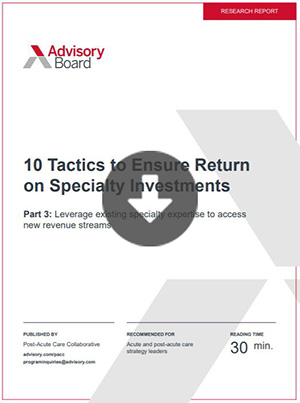Auto logout in seconds.
Continue LogoutThe benefits of specialization can extend beyond volume generation and partnerships within thetraditional bounds of an acute/post-acute relationship. A strong specialty can also open the door tonew business opportunities.
Once a provider develops a successful specialty program, a logical next step is to extend that programto their other locations or care settings.
Continue reading to learn how one inpatient rehabilitation facility (IRF) accessed their traditional patients in a new setting. For more tactics to build and support specialty lines, download our research report excerpt: 10 Tactics to Ensure Specialty Return on Investment, Part 3.
Armfeldt Rehabilitation successfully moved their specialty—rehabilitation following orthopedicsurgery—from an IRF to a sub-acute unit to access their traditional patients in a new setting.Armfeldt had developed significant specialty expertise in treating post-operative orthopedic patients,but changes in medical necessity requirements shifted such patients away from the IRF setting.
To avoid losing that core patient group, as well as their institutional knowledge, Armfeldtpartnered with a local hospital to operate a sub-acute unit specifically for post-operative jointreplacement patients. The unit is a joint venture between Armfeldt and the hospital in which itis located, but accepts patients from all local hospitals. Currently, 60% of the referrals to the unit comefrom other hospitals.
Blog post: The critical mistake providers make when implementing care protocols
Survey insights: What is the current state of preferred provider networks?
When transitioning a specialty to a new care setting, an organization must ensure that the strength of thespecialty is not diluted. While care processes must adjust to meet the needs of the new setting, thesame dedication to high-level specialty care must remain consistent.
To do so, Armfeldt maintained the same level of care for the patients in the sub-acute unit that theyhad offered in their IRF, including delivering frequent, intense therapy not commonly offered in a sub-acute setting. They also followed the same clinical pathways they designed for IRF patients.Patients ambulate early and often, resulting in faster and more complete recovery than at similar sub-acute offerings.
The sub-acute unit breaks even financially, but it provides benefits by generating consumer interest indownstream Armfeldt services, such as home health or outpatient rehab. The program alsostrengthens referring relationships with orthopedists while enabling Armfeldt to continue to servesimple orthopedic patients.
For more tactics to build and support specialty lines, download our research report excerpt: 10 Tactics to Ensure Returnon Specialty Investments, Part 3.
Don't miss out on the latest Advisory Board insights
Create your free account to access 1 resource, including the latest research and webinars.
Want access without creating an account?
You have 1 free members-only resource remaining this month.
1 free members-only resources remaining
1 free members-only resources remaining
You've reached your limit of free insights
Become a member to access all of Advisory Board's resources, events, and experts
Never miss out on the latest innovative health care content tailored to you.
Benefits include:
You've reached your limit of free insights
Become a member to access all of Advisory Board's resources, events, and experts
Never miss out on the latest innovative health care content tailored to you.
Benefits include:
This content is available through your Curated Research partnership with Advisory Board. Click on ‘view this resource’ to read the full piece
Email ask@advisory.com to learn more
Click on ‘Become a Member’ to learn about the benefits of a Full-Access partnership with Advisory Board
Never miss out on the latest innovative health care content tailored to you.
Benefits Include:
This is for members only. Learn more.
Click on ‘Become a Member’ to learn about the benefits of a Full-Access partnership with Advisory Board
Never miss out on the latest innovative health care content tailored to you.


